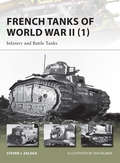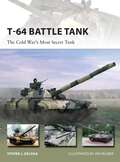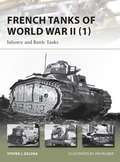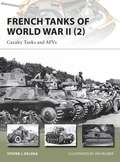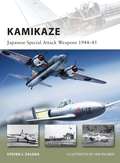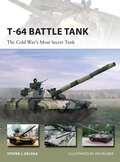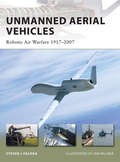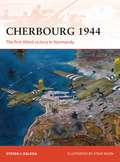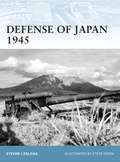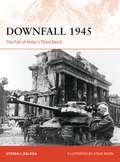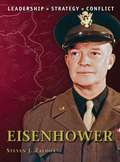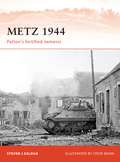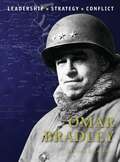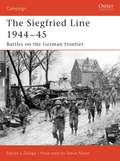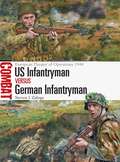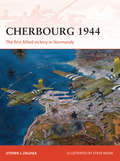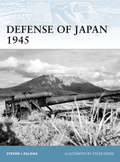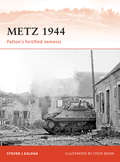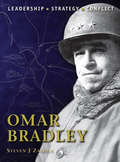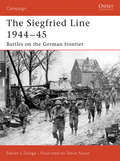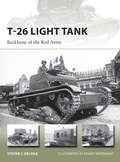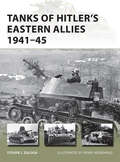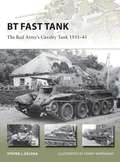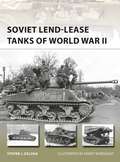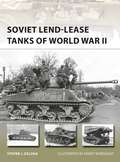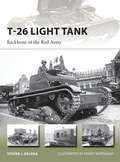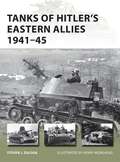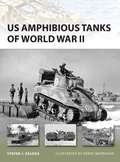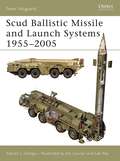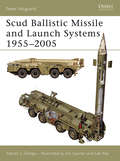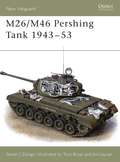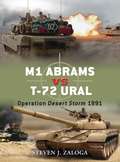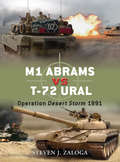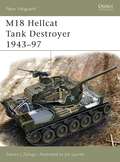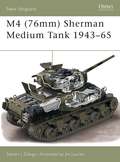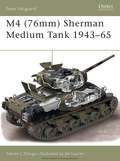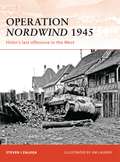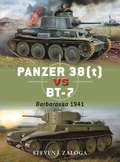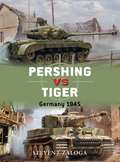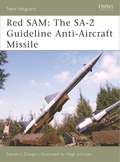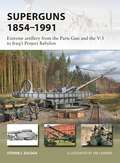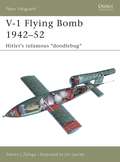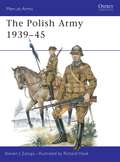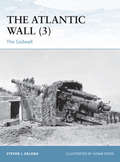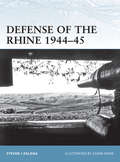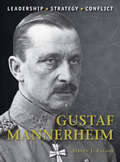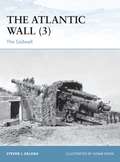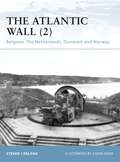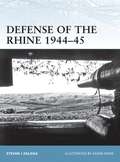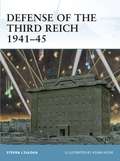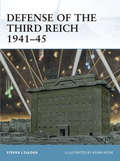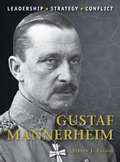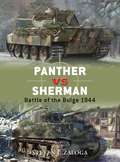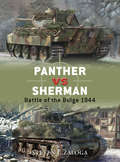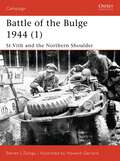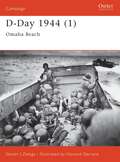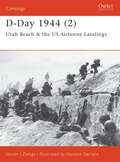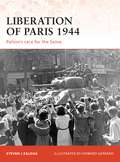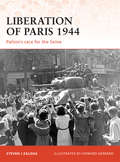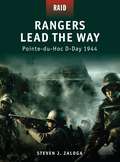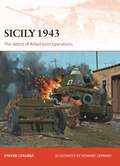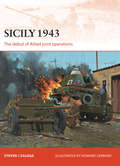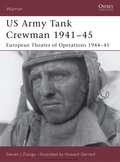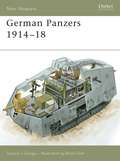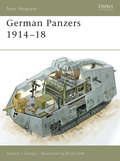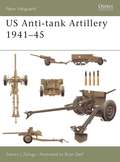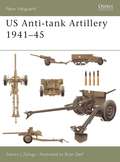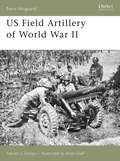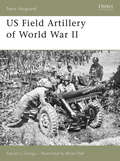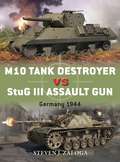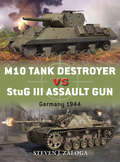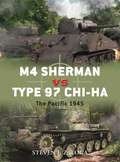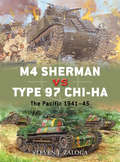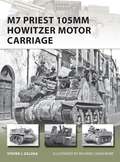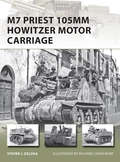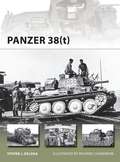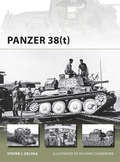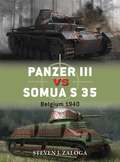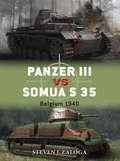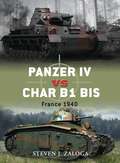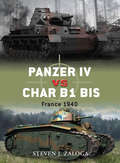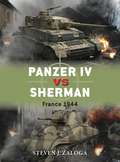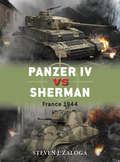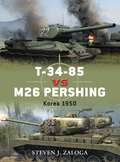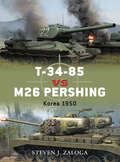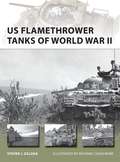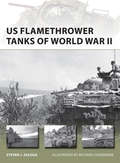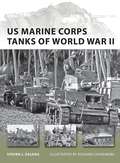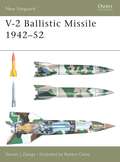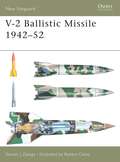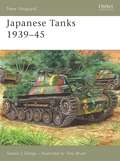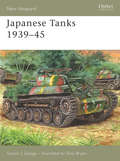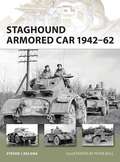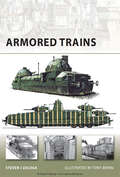- Table View
- List View
French Tanks of World War II: Infantry and Battle Tanks (New Vanguard #209)
by Steven J. Zaloga Mr Ian PalmerThe first of two volumes covering the French armor of World War II, this title looks at the infantry and battle tanks that faced the onslaught of the German Blitzkrieg in 1940. Many of the French tanks were intended as replacements for the World War I-era Renault FT, and various modernization efforts throughout the inter-war years had given rise to a number of new infantry tanks, including the Renault R35 and R40, FCM 36, and the Hotchkiss H35 and H39. Alongside these developments was a separate family of battle tanks, starting with the Renault D1, D2, and, finally, the best-known French tank of the campaign – the Char B1 bis. French Tanks of World War II (1) offers a background to the design and development of these tank types, and an evaluation of their performance in the Battle of France.
T-64 Battle Tank: The Cold War’s Most Secret Tank (New Vanguard #223)
by Steven J. Zaloga Mr Ian PalmerThe T-64 tank was the most revolutionary design of the whole Cold War, designed to provide the firepower and armour protection of a heavy tank in a medium-weight design. It pioneered a host of new technologies including laminate armour, stereoscopic tank rangefinders, opposed-piston engines, smooth-bore tank guns with discarding sabot ammunition, and gun-fired guided projectiles. These impressive features meant that the Russians were loath to part with the secrets of the design, and the T-64 was the only Soviet tank type of the Cold War that was never exported. Written by an armour expert, this detailed technical history sheds light on the secrets behind the Cold War's most controversial tank, revealing how its highly advanced technologies proved to be both a blessing and a curse.
French Tanks of World War II: Infantry and Battle Tanks (New Vanguard)
by Steven J. Zaloga Ian PalmerThe first of two volumes covering the French armor of World War II, this title looks at the infantry and battle tanks that faced the onslaught of the German Blitzkrieg in 1940. Many of the French tanks were intended as replacements for the World War I-era Renault FT, and various modernization efforts throughout the inter-war years had given rise to a number of new infantry tanks, including the Renault R35 and R40, FCM 36, and the Hotchkiss H35 and H39. Alongside these developments was a separate family of battle tanks, starting with the Renault D1, D2, and, finally, the best-known French tank of the campaign – the Char B1 bis. French Tanks of World War II (1) offers a background to the design and development of these tank types, and an evaluation of their performance in the Battle of France.
French Tanks of World War II: Cavalry Tanks and AFVs (New Vanguard)
by Steven J. Zaloga Ian PalmerThe sequel to French Tanks of World War II (1), this title focuses primarily on France's cavalry armored vehicles, including the light reconnaissance tanks such as the AMR and AMC families, the famous Somua S.35 cavalry tanks and the extensive array of armored half-track and armored cars used by the French cavalry. Specific attention is also paid to tanks considered important from a numerical standpoint such as the Hotchkiss H-35/H-39 series. Featuring specially commissioned profile artwork, photographs and illustrations, French Tanks of World War II (2) provides detailed insight into the background and design of these tank types and presents a brief, yet thorough assessment of their performance during the Battle of France.
Kamikaze: Japanese Special Attack Weapons 1944–45 (New Vanguard)
by Steven J. Zaloga Ian PalmerThe destruction of much of the remainder of the Japanese fleet and its air arm in the later half of 1944 left the Japanese Home Islands vulnerable to attack by US naval and air forces. In desperation, the Imperial Japanese Navy proposed using "special attack†? formations, or suicide attacks. These initially consisted of crude improvisations of conventional aircraft fitted with high-explosive bombs that could be crashed into US warships. Called "Divine Wind†? (Kamikaze), the special attack formations first saw action in 1944, and became the scourge of the US fleet in the battles for Iwo Jima and Okinawa in 1945. In view of the success of these attacks, the Japanese armed forces began to develop an entire range of new special attack weapons. This book will begin by examining the initial kamikaze aircraft attacks, but the focus of the book will be on the dedicated special attack weapons developed in 1944. It also covers specialized suicide attack weapons such as anti-tank lunge mines.
T-64 Battle Tank: The Cold War’s Most Secret Tank (New Vanguard)
by Steven J. Zaloga Ian PalmerThe T-64 tank was the most revolutionary design of the whole Cold War, designed to provide the firepower and armour protection of a heavy tank in a medium-weight design. It pioneered a host of new technologies including laminate armour, stereoscopic tank rangefinders, opposed-piston engines, smooth-bore tank guns with discarding sabot ammunition, and gun-fired guided projectiles. These impressive features meant that the Russians were loath to part with the secrets of the design, and the T-64 was the only Soviet tank type of the Cold War that was never exported. Written by an armour expert, this detailed technical history sheds light on the secrets behind the Cold War's most controversial tank, revealing how its highly advanced technologies proved to be both a blessing and a curse.
Unmanned Aerial Vehicles: Robotic Air Warfare 1917–2007 (New Vanguard #144)
by Steven J. Zaloga Ian PalmerUnmanned aerial vehicles (UAVs) are the most dynamic field of aerospace technology, and have only emerged from the shadows recently, despite having been in use for decades. After some limited use in World War II, UAVs emerged as substitutes for manned reconnaissance aircraft in missions deemed too dangerous to risk an aircrew. This book examines the development of UAV technology and speculates on its future potential. Packed with rare, recently declassified photographs and detailed full-colour cutaways, this title goes on to investigate the deployment of UAVs, from early Israeli airforce use to their current role over Iraq and Afghanistan today.
Cherbourg 1944: The first Allied victory in Normandy (Campaign)
by Steven J. Zaloga Steve NoonSteven Zaloga offers up a rigorous and absorbing study of the first major Allied operation in Normandy after the D-Day landings – the capture of Cherbourg. Blending expert analysis, specially commissioned artwork and illustrative maps, this book tells the story of the bitter struggle to capture this vital point. Cherbourg was recognized by both the German and Allied High commands as crucial to the Allied foothold in Normandy – it was the nearest major port and was desperately needed by the Allies for major logistical operations to support their forces on long stretches of open beach. Hitler, on the other hand, declared Cherbourg to be a 'Festung' (fortress), a designation everyone knew to mean that its defenders were to fight to the last man. After a grueling struggle that involved several distinct tactical phases to overcome the different elements of Cherbourg's defence, the campaign resulted in a bittersweet Allied victory, the drama and significance of which are explained in full in this work.
Defense of Japan 1945 (Fortress #99)
by Steven J. Zaloga Steve NoonIn 1945, with her fleet destroyed and her armies beaten, the only thing that stood between Japan and an Allied invasion was the numerous coastal defence positions that surrounded the islands. This is the first book to take a detailed look at the Japanese home island fortifications that were constructed during 1941–45. Utilizing diagrams, specially commissioned artwork, and sources previously unavailable in English, Steven Zaloga examines these defences in the context of a possible Allied invasion, constructing various arguments for one of the greatest 'what if' scenarios of World War II, and helping to explain why the Americans decided to go ahead with a nuclear option.
Downfall 1945: The Fall of Hitler’s Third Reich (Campaign #293)
by Steven J. Zaloga Steve NoonAs the final month of fighting in Europe in 1945 dawned the Allies embarked upon a series of mopping up operations, destroying the last centres of German resistance as the essentially defeated Wehrmacht fought on in increasingly desperate conditions, driven on by the explicit no surrender order issued by Hitler.Yet at the same time, the Allied alliance was already on shaky ground, as German resistance was crushed the Allies began to eye each other nervously across a battletorn Europe, with the politically driven military decisions to have a huge impact on the future of the continent. This book traces the final operations of the war, from the liberation of Denmark, the Allied drive towards the Baltic straits, incursions in Yugoslavia, Hungary, Czechoslovakia and engagements in Eastern and Western Germany, whilst also analyzing how the Allied strategies in the final days of the war were a hint of the future difficulties that would drive the Cold War.
Eisenhower (Command)
by Steven J. Zaloga Steve NoonDwight Eisenhower represented a fundamentally new type of modern military commander. Eisenhower was a manager commander, whose grasp of the politics and large-scale tactics of battle were uniquely suited to leading the huge coalition of forces that fought in Europe during the Second World War. Educated at West Point, Eisenhower rose to his position as Supreme Commander of the Allied Expeditionary Force through a series of powerful contacts and his natural aptitude for leadership and large scale tactical planning. This book analyses how Eisenhower's tactics and political astuteness helped him successfully lead the invasion of Europe, how he coaxed contradictory parties into supporting his policies and how he triumphed in his now infamous clash with Montgomery. Uniquely, the author goes on to describe how Eisenhower's military influence continued when he became President, as his leadership and vision were tested by the outbreak of the Cold War.
Metz 1944: Patton’s fortified nemesis (Campaign #242)
by Steven J. Zaloga Steve NoonGeneral George Patton's most controversial campaign was the series of battles in autumn 1944 battles along the German frontier which centered on the fortified city of Metz. In part, the problem was logistics. As was the case with the rest of the Allied forces in the European Theatre, supplies were limited until the port of Antwerp could finally be cleared. Also problematic was the weather. The autumn of 1944 was one of the wettest on record, and hardly conducive to the type of mechanized warfare for which Patton was so famous. However at the heart of the problem was the accretion of sophisticated fortifications. Metz had been fortified since ancient times, heavily rebuilt by France in the post-Napoleonic period, modernized by Germany in 1870–1914, and modernized by France during the Maginot effort in 1935–40. The Germans hoped to hold Metz with a thin screen of second-rate troops, counting on the impregnable fortifications. This book covers the entire campaign from beginning to end, offering an unbiased assessment of the success and failures of both the Allied and Axis efforts.
Omar Bradley (Command)
by Steven J. Zaloga Steve NoonGeneral Omar Bradley was the premier US Army tactical commander in the European Theatre of Operations in 1944–45. A West Point classmate of Dwight Eisenhower, Bradley was the quintessential US field commander of World War II, elevated to high command with little combat experience but a solid track record as a skilled planner and organiser. Bradley was part of a small cadre of highly skilled young officers groomed for higher command in the austere and bankrupt 1930s. Bradley was at the centre of nearly all the major US Army victories in 1944–45 from D-Day through the final push into Germany. Along with that combat record came a string of controversies. Bradley's greatest blunder, failing to anticipate the German offensive in the Ardennes, was counter-balanced by a vigorous and skilled response which fatally injured the German Army in the West. Beyond the performance of the US Army in the ETO, Bradley was also intimately wrapped up in other controversies, especially the internecine squabbles with his British counterpart, Bernard Montgomery.
Siegfried Line 1944–45: Battles on the German frontier (Campaign)
by Steven J. Zaloga Steve NoonThe campaign on the German frontier in late 1944 was one of the most frustrating and costly efforts by the US Army in the ETO. The Allies first encountered the Siegfried Line (Westwall) fortifications in September 1944, having pursued the retreating Wehrmacht through Belgium and the Netherlands. The border area around Aachen had been fortified with a double line of bunkers, and both the terrain and the weather made things difficult for the Allies. This book focuses on the involvement of the US First and Ninth armies in the six-month fighting, including the hellish fighting for the Hürtgen forest.
US Infantryman vs German Infantryman: European Theater of Operations 1944 (Combat)
by Steven J. Zaloga Steve NoonThe Allied airborne and amphibious landings on D-Day opened up the long-awaited Second Front against Nazi Germany, but after overcoming the German coastal defenses at Utah and "Bloody Omaha,†? the US Army found itself having to contest every hedgerow and street in a nightmarish battle of attrition. It was the humble infantrymen of both sides who would play a vital role in taking and holding key objectives. Battles across Europe tested both sides to the limit, from the close-quarters warfare around Cherbourg in June 1944 to the struggle for the Scharnhorst Line in October and the brutal cold-weather fighting in the Ardennes that December. Featuring full-color artwork, specially drawn maps, and archive photographs, this study offers key insights into the tactics, leadership, and combat performance of the US and German infantrymen pitched into three pivotal actions at the height of World War II.
Cherbourg 1944: The first Allied victory in Normandy (Campaign)
by Steven J. Zaloga Mr Steve NoonSteven Zaloga offers up a rigorous and absorbing study of the first major Allied operation in Normandy after the D-Day landings – the capture of Cherbourg. Blending expert analysis, specially commissioned artwork and illustrative maps, this book tells the story of the bitter struggle to capture this vital point. Cherbourg was recognized by both the German and Allied High commands as crucial to the Allied foothold in Normandy – it was the nearest major port and was desperately needed by the Allies for major logistical operations to support their forces on long stretches of open beach. Hitler, on the other hand, declared Cherbourg to be a 'Festung' (fortress), a designation everyone knew to mean that its defenders were to fight to the last man. After a grueling struggle that involved several distinct tactical phases to overcome the different elements of Cherbourg's defence, the campaign resulted in a bittersweet Allied victory, the drama and significance of which are explained in full in this work.
Defense of Japan 1945 (Fortress #99)
by Steven J. Zaloga Mr Steve NoonIn 1945, with her fleet destroyed and her armies beaten, the only thing that stood between Japan and an Allied invasion was the numerous coastal defence positions that surrounded the islands. This is the first book to take a detailed look at the Japanese home island fortifications that were constructed during 1941–45. Utilizing diagrams, specially commissioned artwork, and sources previously unavailable in English, Steven Zaloga examines these defences in the context of a possible Allied invasion, constructing various arguments for one of the greatest 'what if' scenarios of World War II, and helping to explain why the Americans decided to go ahead with a nuclear option.
Metz 1944: Patton’s fortified nemesis (Campaign #242)
by Steven J. Zaloga Mr Steve NoonGeneral George Patton's most controversial campaign was the series of battles in autumn 1944 battles along the German frontier which centered on the fortified city of Metz. In part, the problem was logistics. As was the case with the rest of the Allied forces in the European Theatre, supplies were limited until the port of Antwerp could finally be cleared. Also problematic was the weather. The autumn of 1944 was one of the wettest on record, and hardly conducive to the type of mechanized warfare for which Patton was so famous. However at the heart of the problem was the accretion of sophisticated fortifications. Metz had been fortified since ancient times, heavily rebuilt by France in the post-Napoleonic period, modernized by Germany in 1870–1914, and modernized by France during the Maginot effort in 1935–40. The Germans hoped to hold Metz with a thin screen of second-rate troops, counting on the impregnable fortifications. This book covers the entire campaign from beginning to end, offering an unbiased assessment of the success and failures of both the Allied and Axis efforts.
Omar Bradley (Command #25)
by Steven J. Zaloga Mr Steve NoonGeneral Omar Bradley was the premier US Army tactical commander in the European Theatre of Operations in 1944–45. A West Point classmate of Dwight Eisenhower, Bradley was the quintessential US field commander of World War II, elevated to high command with little combat experience but a solid track record as a skilled planner and organiser. Bradley was part of a small cadre of highly skilled young officers groomed for higher command in the austere and bankrupt 1930s. Bradley was at the centre of nearly all the major US Army victories in 1944–45 from D-Day through the final push into Germany. Along with that combat record came a string of controversies. Bradley's greatest blunder, failing to anticipate the German offensive in the Ardennes, was counter-balanced by a vigorous and skilled response which fatally injured the German Army in the West. Beyond the performance of the US Army in the ETO, Bradley was also intimately wrapped up in other controversies, especially the internecine squabbles with his British counterpart, Bernard Montgomery.
Siegfried Line 1944–45: Battles on the German frontier (Campaign)
by Steven J. Zaloga Mr Steve NoonThe campaign on the German frontier in late 1944 was one of the most frustrating and costly efforts by the US Army in the ETO. The Allies first encountered the Siegfried Line (Westwall) fortifications in September 1944, having pursued the retreating Wehrmacht through Belgium and the Netherlands. The border area around Aachen had been fortified with a double line of bunkers, and both the terrain and the weather made things difficult for the Allies. This book focuses on the involvement of the US First and Ninth armies in the six-month fighting, including the hellish fighting for the Hürtgen forest.
US Infantryman vs German Infantryman: European Theater of Operations 1944 (Combat #15)
by Steven J. Zaloga Mr Steve NoonThe Allied airborne and amphibious landings on D-Day opened up the long-awaited Second Front against Nazi Germany, but after overcoming the German coastal defenses at Utah and "Bloody Omaha,†? the US Army found itself having to contest every hedgerow and street in a nightmarish battle of attrition. It was the humble infantrymen of both sides who would play a vital role in taking and holding key objectives. Battles across Europe tested both sides to the limit, from the close-quarters warfare around Cherbourg in June 1944 to the struggle for the Scharnhorst Line in October and the brutal cold-weather fighting in the Ardennes that December. Featuring full-color artwork, specially drawn maps, and archive photographs, this study offers key insights into the tactics, leadership, and combat performance of the US and German infantrymen pitched into three pivotal actions at the height of World War II.
T-26 Light Tank: Backbone of the Red Army (New Vanguard)
by Steven J. Zaloga Mr Henry MorsheadThe T-26 was the first major Soviet armour program of the 1930s, beginning as a license-built version of the British Vickers 6-ton export tank. Although the T-26 retained the basic Vickers hull and suspension, the Red Army began to make extensive changes to the turret and armament, starting with the addition of a 45mm tank gun in 1933. The T-26 was built in larger numbers than any other tank prior to World War II. Indeed, more T-26 tanks were manufactured than the combined tank production of Germany, France, Britain, and the United States in 1931–40. This book surveys the development of the T-26 as well as its combat record in the Spanish Civil War, the war in China, the border wars with Poland and Finland in 1939–40, and the disastrous battles of 1941 during Operation Barbarossa.
Tanks of Hitler’s Eastern Allies 1941–45 (New Vanguard #199)
by Steven J. Zaloga Mr Henry MorsheadThe titanic armor battles of the Russian Front are widely known, but the role of Germany's eastern allies is not as well known. Two of these countries, Romania and Hungary, manufactured their own tanks as well as purchasing tanks from Germany. These ranged from older, obsolete types such as the PzKpfw 35(t) all the way up to the latest and best German vehicles including the Tiger I and Hetzer. These tanks played a frequent role in the battles in southern Russia and Ukraine and were especially prominent in the disaster at Stalingrad where the Red Army specifically chose the weaker Romanian and Hungarian salients for their critical envelopment operation. This New Vanguard will provide a broad survey of the various and colorful tanks used. Besides covering the largest of these Axis tank forces, this book will cover the many smaller and lesser known forces including the Italian contingent in Russia, the Finnish armored force, and the small but interesting armored forces of the Russian Vlasov (RONA), Croatian, Bulgarian and Slovakian armies. This subject is seeing increasing interest in the modeling world; for example Tamiya recently announced a PzKpfw 35 (t) (suitable for Romanian, Slovak armies) a Finnish StuG III, and a Finnish BT-42.
BT Fast Tank: The Red Army’s Cavalry Tank 1931–45 (New Vanguard #237)
by Steven J. Zaloga Henry MorsheadWhen the Red Army needed to mechanize its cavalry branch in the 1930s, the BT fast tank was its solution. Based on the American Christie high-speed tank, the Red Army began a program to adapt the design to its own needs. Early versions were mechanically unreliable and poorly armed but by the mid-1930s, the BT-5 emerged, armed with an excellent dual-purpose 45mm gun. It saw its combat debut in the Spanish Civil War in 1937 and was later used in the border battles with the Japanese Kwangtung Army in the late 1930s. The final production series, the BT-7, was the most refined version of the family.One of the most common types in Red Army service in the first years of the Second World War, BT tanks saw extensive combat in Poland, Finland, and the opening phases of Operation Barbarossa in 1941 and latterly during the 1945 campaign against the Japanese in Manchuria – this is the story of their design and development history.
Soviet Lend-Lease Tanks of World War II (New Vanguard)
by Steven J. Zaloga Henry MorsheadThe Red Army suffered such catastrophic losses of armour in the summer of 1941 that they begged Britain and the United States to send tanks. The first batches arrived in late 1941, just in time to take part in the defence of Moscow. The supplies of British tanks encompassed a very wide range of types including the Matilda, Churchill, and Valentine and even a few Tetrarch airborne tanks. American tanks included the M3 (Stuart) light tank and M3 (Lee) medium tank and the M4 Sherman tank, which became so common in 1944–45 that entire Soviet tank corps were equipped with the type. With these Western tanks, the Soviets were finally able to beat back the German tide in the East.This study examines the different types of tanks shipped to the Soviet Union during the war, Soviet assessments of their merits and problems, and combat accounts of their use in Soviet service using full colour artwork, contemporary photographs and detailed cut-away illustrations.
Soviet Lend-Lease Tanks of World War II (New Vanguard)
by Steven J. Zaloga Henry MorsheadThe Red Army suffered such catastrophic losses of armour in the summer of 1941 that they begged Britain and the United States to send tanks. The first batches arrived in late 1941, just in time to take part in the defence of Moscow. The supplies of British tanks encompassed a very wide range of types including the Matilda, Churchill, and Valentine and even a few Tetrarch airborne tanks. American tanks included the M3 (Stuart) light tank and M3 (Lee) medium tank and the M4 Sherman tank, which became so common in 1944–45 that entire Soviet tank corps were equipped with the type. With these Western tanks, the Soviets were finally able to beat back the German tide in the East.This study examines the different types of tanks shipped to the Soviet Union during the war, Soviet assessments of their merits and problems, and combat accounts of their use in Soviet service using full colour artwork, contemporary photographs and detailed cut-away illustrations.
T-26 Light Tank: Backbone of the Red Army (New Vanguard)
by Steven J. Zaloga Henry MorsheadThe T-26 was the first major Soviet armour program of the 1930s, beginning as a license-built version of the British Vickers 6-ton export tank. Although the T-26 retained the basic Vickers hull and suspension, the Red Army began to make extensive changes to the turret and armament, starting with the addition of a 45mm tank gun in 1933. The T-26 was built in larger numbers than any other tank prior to World War II. Indeed, more T-26 tanks were manufactured than the combined tank production of Germany, France, Britain, and the United States in 1931–40. This book surveys the development of the T-26 as well as its combat record in the Spanish Civil War, the war in China, the border wars with Poland and Finland in 1939–40, and the disastrous battles of 1941 during Operation Barbarossa.
Tanks of Hitler’s Eastern Allies 1941–45 (New Vanguard)
by Steven J. Zaloga Henry MorsheadThe titanic armor battles of the Russian Front are widely known, but the role of Germany's eastern allies is not as well known. Two of these countries, Romania and Hungary, manufactured their own tanks as well as purchasing tanks from Germany. These ranged from older, obsolete types such as the PzKpfw 35(t) all the way up to the latest and best German vehicles including the Tiger I and Hetzer. These tanks played a frequent role in the battles in southern Russia and Ukraine and were especially prominent in the disaster at Stalingrad where the Red Army specifically chose the weaker Romanian and Hungarian salients for their critical envelopment operation. This New Vanguard will provide a broad survey of the various and colorful tanks used. Besides covering the largest of these Axis tank forces, this book will cover the many smaller and lesser known forces including the Italian contingent in Russia, the Finnish armored force, and the small but interesting armored forces of the Russian Vlasov (RONA), Croatian, Bulgarian and Slovakian armies. This subject is seeing increasing interest in the modeling world; for example Tamiya recently announced a PzKpfw 35 (t) (suitable for Romanian, Slovak armies) a Finnish StuG III, and a Finnish BT-42.
US Amphibious Tanks of World War II (New Vanguard #192)
by Steven J. Zaloga Henry MorsheadThe advent of combined arms operations in World War II created the need for specialized armored vehicles. In the case of amphibious attacks, the issue arose of how best to land tanks on a beach. Although a variety of specialized landing craft were developed, the Dieppe raid in 1942 encouraged the development of tanks that could be deployed from further off-shore to limit the vulnerability of the LCT craft. The deep-wading equipment that they developed was first used during Operation Husky on Sicily in July 1943, and subsequently for Operations Avalanche (Salerno, September 1943), Shingle (Anzio, January 1944) and Overlord (Normandy, June 1944). The US-manufactured DD tanks were used during Overlord by both US and British forces, and again in 1945 during the Rhine crossings. Initially, developments in the Pacific Theater were separate from those in Europe. The Marines learned from the Tarawa landings in 1943 that unprepared tanks could not be safely landed even in shallow water. DD tanks were never seriously considered for the Pacific, so other solutions were sought. A detailed study of specialized US amphibious tanks, this is a title that will appeal to those interested in both Pacific and European Theaters, modellers and collectors.
Scud Ballistic Missile and Launch Systems 1955–2005 (New Vanguard)
by Steven J. Zaloga Jim Laurier Lee RayThe Scud missile was developed as the centerpiece of Soviet plans to fight nuclear war in the heart of Europe. However, it was never used in its intended role and has instead become a symbol of the changing nature of warfare in the aftermath of the Cold War. Saddam Hussein's Iraqi armed forces were almost helpless in the face of the Coalition forces in the 1991 Gulf War; the only weapon that Iraq could use to injure the Coalition forces was its arsenal of Scud missiles. This book explores the development and variants of the missile and its launch systems, its proliferation outside of the West, and its role in conflicts around the world.
Scud Ballistic Missile and Launch Systems 1955–2005 (New Vanguard)
by Steven J. Zaloga Jim Laurier Lee RayThe Scud missile was developed as the centerpiece of Soviet plans to fight nuclear war in the heart of Europe. However, it was never used in its intended role and has instead become a symbol of the changing nature of warfare in the aftermath of the Cold War. Saddam Hussein's Iraqi armed forces were almost helpless in the face of the Coalition forces in the 1991 Gulf War; the only weapon that Iraq could use to injure the Coalition forces was its arsenal of Scud missiles. This book explores the development and variants of the missile and its launch systems, its proliferation outside of the West, and its role in conflicts around the world.
M26/M46 Pershing Tank 1943–53 (New Vanguard #35)
by Steven J. Zaloga Jim Laurier Tony BryanFrom the moment that the M4 Sherman had been matched against German Panther and Tiger tanks, the American tank crews had known that their vehicles were outclassed by the opposition. What was needed was a more powerful tank, more heavily armed and armored, that could take-on the powerful German panzers on a more equal footing. Although it took time to develop by the latter months of the war numbers of M26 Pershing tanks were reaching the frontline US armored units. Well armored and with a powerful 90mm gun the Pershing was a match for any tank in the German order of battle.
M1 Abrams vs T-72 Ural: Operation Desert Storm 1991 (Duel #18)
by Steven J. Zaloga Jim LaurierThe Gulf War bore witness to a number of deadly encounters between these two great adversaries. Heavily armoured, highly mobile and capable of killing at over 2500m the M1 Abrams is, to this day, a veritable fighting machine. Superior to both Iraq's Soviet era T-55 and T-62 tanks, nearly all sources claim that no Abrams tank has ever been destroyed by enemy fire. Despite entering service in 1980, the M1 Abrams remained untested in combat until the Gulf War in 1991, where it was to be confronted by its archenemy the Iraqi-assembled Soviet-designed T-72. Entering production in 1971, the T-72 arguably outstripped its contemporaries in a balance of mobility, protection and firepower. By the time of Operation Desert Storm, however, the tables had turned and the tank suffered due to low quality ammunition and poorly trained crews. In this fascinating study, Steven Zaloga pits these two great fighting machines against one another, plotting the development of the Cold War until both tanks met in combat in the deserts of Iraq and Kuwait.
M1 Abrams vs T-72 Ural: Operation Desert Storm 1991 (Duel #18)
by Steven J. Zaloga Jim LaurierThe Gulf War bore witness to a number of deadly encounters between these two great adversaries. Heavily armoured, highly mobile and capable of killing at over 2500m the M1 Abrams is, to this day, a veritable fighting machine. Superior to both Iraq's Soviet era T-55 and T-62 tanks, nearly all sources claim that no Abrams tank has ever been destroyed by enemy fire. Despite entering service in 1980, the M1 Abrams remained untested in combat until the Gulf War in 1991, where it was to be confronted by its archenemy the Iraqi-assembled Soviet-designed T-72. Entering production in 1971, the T-72 arguably outstripped its contemporaries in a balance of mobility, protection and firepower. By the time of Operation Desert Storm, however, the tables had turned and the tank suffered due to low quality ammunition and poorly trained crews. In this fascinating study, Steven Zaloga pits these two great fighting machines against one another, plotting the development of the Cold War until both tanks met in combat in the deserts of Iraq and Kuwait.
M18 Hellcat Tank Destroyer 1943–97 (New Vanguard)
by Steven J. Zaloga Jim LaurierThe M18 76mm Gun Motor Carriage was developed for the US Army's Tank Destroyer Command. It was the only tank destroyer deployed during World War II actually based on their requirements for speed and firepower. This book examines the development of this vehicle, the controversies over the need for high-speed tank destroyers, and its actual performance during World War II. Special emphasis is placed on examining its performance in its intended mission. Coverage also includes derivative vehicles of the M18 such as the M39 armored utility vehicle.
M18 Hellcat Tank Destroyer 1943–97 (New Vanguard #97)
by Steven J. Zaloga Jim LaurierThe M18 76mm Gun Motor Carriage was developed for the US Army's Tank Destroyer Command. It was the only tank destroyer deployed during World War II actually based on their requirements for speed and firepower. This book examines the development of this vehicle, the controversies over the need for high-speed tank destroyers, and its actual performance during World War II. Special emphasis is placed on examining its performance in its intended mission. Coverage also includes derivative vehicles of the M18 such as the M39 armored utility vehicle.
M4 (New Vanguard)
by Steven J. Zaloga Jim LaurierThe M4 Sherman tank was the mainstay of the Western allies between 1942 and 1945. Fast and modern it was a big success and was transported as far afield as Russia and North Africa. The American Chief of Staff claimed in November 1943 it was 'hailed widely as the best tank on the battlefield today…'. However, by the Normandy invasion of June 1944 this was not the case: the new German heavy tanks such as the Panther and Tiger were completely outclassing the Sherman. This title covers the M4 version armed with the 76 mm gun, examining developments such as the HVSS suspension, using much new archive material.
M4 (New Vanguard #73)
by Steven J. Zaloga Jim LaurierThe M4 Sherman tank was the mainstay of the Western allies between 1942 and 1945. Fast and modern it was a big success and was transported as far afield as Russia and North Africa. The American Chief of Staff claimed in November 1943 it was 'hailed widely as the best tank on the battlefield today…'. However, by the Normandy invasion of June 1944 this was not the case: the new German heavy tanks such as the Panther and Tiger were completely outclassing the Sherman. This title covers the M4 version armed with the 76 mm gun, examining developments such as the HVSS suspension, using much new archive material.
Operation Nordwind 1945: Hitler’s last offensive in the West (Campaign #223)
by Steven J. Zaloga Jim LaurierOperation Nordwind is one of the lesser known campaigns of World War II yet one of the more intriguing. Largely overshadowed by the Battle of the Bulge further north, Nordwind was the last great operation by the Waffen-SS Panzer divisions in the west, and the last time the Wehrmacht was on the offensive in the West. The campaign also highlights the difficulties of inter-Allied cooperation between the Americans and the French. This campaign has been extensively treated in German and French accounts, but is not well covered in English.
Panzer 38: Barbarossa 1941 (Duel #78)
by Steven J. Zaloga Jim LaurierThe tank battles in the Soviet Union during the summer of 1941 were the largest in World War II, exceeding even the more famous Prokhorovka encounter during the Kursk campaign. Indeed, they were the largest tank battles ever fought. This book examines two evenly matched competitors in this conflict, the German Panzer 38(t) and the Soviet BT-7. Both were of similar size, armed with guns of comparable firepower, and had foreign roots – the Panzer 38(t) was a Czechoslovak design and the BT-7 was an evolution of the American Christie tank. With full-colour artwork and archive and present-day photography, this absorbing study assesses the strengths and limitations of these two types against the wider background of armoured doctrine in the opening stages of Operation Barbarossa.
Panzer 38: Barbarossa 1941 (Duel #78)
by Steven J. Zaloga Jim LaurierThe tank battles in the Soviet Union during the summer of 1941 were the largest in World War II, exceeding even the more famous Prokhorovka encounter during the Kursk campaign. Indeed, they were the largest tank battles ever fought. This book examines two evenly matched competitors in this conflict, the German Panzer 38(t) and the Soviet BT-7. Both were of similar size, armed with guns of comparable firepower, and had foreign roots – the Panzer 38(t) was a Czechoslovak design and the BT-7 was an evolution of the American Christie tank. With full-colour artwork and archive and present-day photography, this absorbing study assesses the strengths and limitations of these two types against the wider background of armoured doctrine in the opening stages of Operation Barbarossa.
Pershing vs Tiger: Germany 1945 (Duel)
by Steven J. Zaloga Jim LaurierDuring the final battles on World War II's Western Front, the legendary German Tiger I heavy tank clashed with the brand-new M26 Pershing fielded by the United States. The Tiger I had earned a formidable reputation by the end of 1944, although its non-sloped armour and poor mobility meant it was being superseded by the Tiger II or 'King Tiger'. While the Tiger I had been in the front lines since 1942, the US Pershing first entered combat in late February 1945, and more than 20 Pershings would see action before war's end.This book examines the dramatic Tiger/Pershing duel at Elsdorf in Germany, and also assesses the clashes between German armour and the sole 'Super Pershing' deployed to Europe. Featuring full-colour artwork, carefully chosen photographs and specially commissioned maps, this is the story of the first US heavy tanks in combat with the fearsome Tiger I during the last months of World War II in Europe.
Pershing vs Tiger: Germany 1945 (Duel)
by Steven J. Zaloga Jim LaurierDuring the final battles on World War II's Western Front, the legendary German Tiger I heavy tank clashed with the brand-new M26 Pershing fielded by the United States. The Tiger I had earned a formidable reputation by the end of 1944, although its non-sloped armour and poor mobility meant it was being superseded by the Tiger II or 'King Tiger'. While the Tiger I had been in the front lines since 1942, the US Pershing first entered combat in late February 1945, and more than 20 Pershings would see action before war's end.This book examines the dramatic Tiger/Pershing duel at Elsdorf in Germany, and also assesses the clashes between German armour and the sole 'Super Pershing' deployed to Europe. Featuring full-colour artwork, carefully chosen photographs and specially commissioned maps, this is the story of the first US heavy tanks in combat with the fearsome Tiger I during the last months of World War II in Europe.
Red SAM: The SA-2 Guideline Anti-Aircraft Missile (New Vanguard #134)
by Steven J. Zaloga Jim LaurierThe Russian SA-2, nicknamed "Red SAM,†? is history's dominant antiaircraft missile. In 1960 it famously downed Gary Powers' U-2 spyplane, and two years later it was one of the missiles deployed during the Cuban Missile Crisis, which almost sparked a nuclear showdown between America and the USSR. The SA-2 was also deployed in Vietnam, North Korea, Egypt, and even the Gulf War. Using photographs, color artwork, and rare accounts from the weapon's designers, Steven J Zaloga examines the missile's development, linking this to its massive impact on Cold War air campaigns, and investigates the design changes that have helped the SA-2 stand the test of time.
Superguns 1854–1991: Extreme artillery from the Paris Gun and the V-3 to Iraq's Project Babylon (New Vanguard #265)
by Steven J. Zaloga Jim LaurierOver the last 150 years, gun designers have sought to transform warfare with artillery of superlative range and power, from William Armstrong's 19th-century “monster guns” to the latest research into hypersonic electro-magnetic railguns.Taking a case study approach, Superguns explains the technology and role of the finest monster weapons of each era. It looks at the 1918 “Wilhelm Gun,” designed to shell Paris from behind the German trenches; the World War II “V-3” gun built to bombard London across the Channel; the Cold War atomic cannons of the US and Soviet Union; and the story of Dr Gerald Bull's HARP program and the Iraqi “Supergun” he designed for Saddam Hussein. Illustrated throughout, this is an authoritative history of the greatest and most ambitious artillery pieces of all time.
V-1 Flying Bomb 1942–52: Hitler’s infamous "doodlebug†? (New Vanguard #106)
by Steven J. Zaloga Jim LaurierThe first deployment of the V-1 was in June 1944 when, following two years of tests, Hitler gave the order to attack England. Known to the Allies as the "Buzz Bomb" or "Doodlebug", the V-1 was the world's first cruise missile. This book explores the V-1 in detail, from its initial concept, first use in 1944, the various Allied counter-measures, and the later use of the V-1 during the Battle of the Bulge. The major foreign derivatives, including the US copy "JB-2 Loon" and numerous post-war Soviet variants, are also covered.
The Polish Army 1939–45 (Men-at-Arms #117)
by Steven J. Zaloga Richard HookPoland was the first of the Allied nations to succumb to German aggression in the Second World War, but by the most tortuous of routes her army managed to remain in the field through all five years of bloody fighting. Polish soldiers fought in nearly every major campaign in the European theatre, and their tale is a complicated and tragic one. This richly detailed text by Steven Zaloga relates the story of the Polish Army during the Second World War, from the first wave of Stukas in 1939 to its eventual conclusion.
The Polish Army 1939–45 (Men-at-Arms #117)
by Steven J. Zaloga Richard HookPoland was the first of the Allied nations to succumb to German aggression in the Second World War, but by the most tortuous of routes her army managed to remain in the field through all five years of bloody fighting. Polish soldiers fought in nearly every major campaign in the European theatre, and their tale is a complicated and tragic one. This richly detailed text by Steven Zaloga relates the story of the Polish Army during the Second World War, from the first wave of Stukas in 1939 to its eventual conclusion.
The Atlantic Wall: The Sudwall (Fortress #109)
by Steven J. Zaloga Mr Adam HookThis book completes the story of one of the most formidable defensive lines in Europe in World War II, looking at the lesser known Mediterranean extension and describing how it was conceived of, built and used. After the alarming collapse of Italy in 1943, the Germans launched a crash building program and the 'Sudwall' (South Wall) sprang up quickly along the French Mediterranean coast and the neighbouring Italian coast around Genoa. The new defenses were bolstered by existing French fortifications of key port towns such as Marseilles and Toulon – many of them bristling with heavy artillery. Whilst describing the wall's physical design features, this book also recounts the defenses' role in the Allied invasion of Southern France; Operation Dragoon – 'The Second D-Day'. As the Germans' worst fears became a reality, the southern Atlantic Wall would face its ultimate test.
Defense of the Rhine 1944–45 (Fortress #102)
by Steven J. Zaloga Mr Adam HookThe Rhine River represented the last natural defensive barrier for the Third Reich in the autumn of 1944. Although Hitler had been reluctant to allow the construction of tactical defence lines in France, the final defense of the Reich was another matter. As a result, construction of a Rhine defence line began in September 1944. Steven J. Zaloga examines the multiple phases of construction undertaken to strengthen the Westwall (Siegfried Line), to fortify many of the border villages, and finally to prepare for the demolition of the Rhine bridges. Using detailed maps, colour artwork, and expert analysis, this book takes a detailed look at Germany's last line of defence.
Gustaf Mannerheim (Command #32)
by Steven J. Zaloga Mr Adam HookCarl Gustaf Emil Mannerheim is a legendary figure, whose life and career were deeply influential in Finnish and European history. He is viewed by many as the father of modern Finland after leading the 'White' faction to victory and independence in the Finnish Civil War of 1918. He then commanded his country's forces in a sequence of bitter clashes in the ice and snow, in the build-up to, and during, World War II: the Winter War in 1939–40, the Continuation War in 1941–44 and the Lapland War in 1944–45. This study provides a fascinating insight into Mannerheim's career, analysing his traits, his biggest victories and his key enemies. Complete with uniform artwork and detailed tactical maps, it is a comprehensive guide to one of the 20th century's most capable military leaders and statesmen.
The Atlantic Wall: The Sudwall (Fortress)
by Steven J. Zaloga Adam HookThis book completes the story of one of the most formidable defensive lines in Europe in World War II, looking at the lesser known Mediterranean extension and describing how it was conceived of, built and used. After the alarming collapse of Italy in 1943, the Germans launched a crash building program and the 'Sudwall' (South Wall) sprang up quickly along the French Mediterranean coast and the neighbouring Italian coast around Genoa. The new defenses were bolstered by existing French fortifications of key port towns such as Marseilles and Toulon – many of them bristling with heavy artillery. Whilst describing the wall's physical design features, this book also recounts the defenses' role in the Allied invasion of Southern France; Operation Dragoon – 'The Second D-Day'. As the Germans' worst fears became a reality, the southern Atlantic Wall would face its ultimate test.
The Atlantic Wall: Belgium, The Netherlands, Denmark and Norway (Fortress #89)
by Steven J. Zaloga Adam HookGermany's Atlantic Wall was the most ambitious military fortification program of World War II. Following its conquest of Western Europe, Germany had to defend some 5,000km of Atlantic coastline from the Spanish border to the Arctic Circle. The United States' entry into the war and the inevitability of an Anglo-American landing in Western Europe resulted in the fortification of this coastline along its entire length. Focusing on the northern Atlantic Wall in the Low Countries and Scandinavia, this title addresses the special defensive features and unique aspects of fortification in these countries, such as the early focus on fortifying Norway, due to early British commando raids; the greater use of turreted naval guns; and the establishment of first-line Flak defences in the Low Countries to counter the Allied strategic bombing campaign.
Defense of the Rhine 1944–45 (Fortress)
by Steven J. Zaloga Adam HookThe Rhine River represented the last natural defensive barrier for the Third Reich in the autumn of 1944. Although Hitler had been reluctant to allow the construction of tactical defence lines in France, the final defense of the Reich was another matter. As a result, construction of a Rhine defence line began in September 1944. Steven J. Zaloga examines the multiple phases of construction undertaken to strengthen the Westwall (Siegfried Line), to fortify many of the border villages, and finally to prepare for the demolition of the Rhine bridges. Using detailed maps, colour artwork, and expert analysis, this book takes a detailed look at Germany's last line of defence.
Defense of the Third Reich 1941–45 (Fortress)
by Steven J. Zaloga Adam HookStarting in 1940, Germany was subjected to a growing threat of Allied bomber attack. The RAF night bombing offensive built up in a slow but unrelenting crescendo through the Ruhr campaign in the summer of 1944 and culminating in the attacks on Berlin in the autumn and early winter of 1943-44. They were joined by US daylight raids which first began to have a serious impact on German industry in the autumn of 1943. This book focuses on the land-based infrastructure of Germany's defense against the air onslaught. Besides active defense against air attack, Germany also invested heavily in passive defense such as air raid shelters. While much of this defense was conventional such as underground shelters and the dual use of subways and other structures, Germany faced some unique dilemmas in protecting cities against night fire bomb raids. As a result, German architects designed massive above-ground defense shelters which were amongst the most massive defensive structures built in World War II.
Defense of the Third Reich 1941–45 (Fortress #107)
by Steven J. Zaloga Adam HookStarting in 1940, Germany was subjected to a growing threat of Allied bomber attack. The RAF night bombing offensive built up in a slow but unrelenting crescendo through the Ruhr campaign in the summer of 1944 and culminating in the attacks on Berlin in the autumn and early winter of 1943-44. They were joined by US daylight raids which first began to have a serious impact on German industry in the autumn of 1943. This book focuses on the land-based infrastructure of Germany's defense against the air onslaught. Besides active defense against air attack, Germany also invested heavily in passive defense such as air raid shelters. While much of this defense was conventional such as underground shelters and the dual use of subways and other structures, Germany faced some unique dilemmas in protecting cities against night fire bomb raids. As a result, German architects designed massive above-ground defense shelters which were amongst the most massive defensive structures built in World War II.
Gustaf Mannerheim (Command)
by Steven J. Zaloga Adam HookCarl Gustaf Emil Mannerheim is a legendary figure, whose life and career were deeply influential in Finnish and European history. He is viewed by many as the father of modern Finland after leading the 'White' faction to victory and independence in the Finnish Civil War of 1918. He then commanded his country's forces in a sequence of bitter clashes in the ice and snow, in the build-up to, and during, World War II: the Winter War in 1939–40, the Continuation War in 1941–44 and the Lapland War in 1944–45. This study provides a fascinating insight into Mannerheim's career, analysing his traits, his biggest victories and his key enemies. Complete with uniform artwork and detailed tactical maps, it is a comprehensive guide to one of the 20th century's most capable military leaders and statesmen.
Panther vs Sherman: Battle of the Bulge 1944 (Duel #13)
by Steven J. Zaloga Howard Gerrard Jim LaurierIn this book Steven J Zaloga offers a fascinating comparison between the two most important tanks involved in the crucial fighting of 1944, the American Sherman and the German Panther. Placing the reader in the heart of this battle between quality and quantity Zaloga uses a compelling account of the ferocious fighting during the Battle of the Bulge to explain the successes and failures of each tank, highlighting the fact that a tank can only be as good as its crew, weighing up the impact of low morale, high cost and mediocre crew training on the Panther's superiority. With full-colour battlescenes, technical drawings, photographs, digital gunsight views, extracts from crew training manuals and real combat reports, this book brings the titanic battles between the Panther and Sherman to life.
Panther vs Sherman: Battle of the Bulge 1944 (Duel #13)
by Steven J. Zaloga Howard Gerrard Jim LaurierIn this book Steven J Zaloga offers a fascinating comparison between the two most important tanks involved in the crucial fighting of 1944, the American Sherman and the German Panther. Placing the reader in the heart of this battle between quality and quantity Zaloga uses a compelling account of the ferocious fighting during the Battle of the Bulge to explain the successes and failures of each tank, highlighting the fact that a tank can only be as good as its crew, weighing up the impact of low morale, high cost and mediocre crew training on the Panther's superiority. With full-colour battlescenes, technical drawings, photographs, digital gunsight views, extracts from crew training manuals and real combat reports, this book brings the titanic battles between the Panther and Sherman to life.
Battle of the Bulge 1944: St Vith and the Northern Shoulder (Campaign)
by Steven J. Zaloga Howard GerrardThe Battle of the Bulge was the largest and most costly battle fought by the US Army in World War II. The Ardennes fighting was Hitler's last gamble on the Western Front, crippling the Wehrmacht for the remainder of the war. In the first of two volumes on the Ardennes campaign Steven Zaloga details the fighting in the northern sector around St Vith and the Elsenborn Ridge. Sixth Panzer Army, containing the bulk of German Panzer strength, was expected to achieve the breakthrough here. It was the failure around St Vith that forced the Germans to look south towards Bastogne.
D-Day 1944: Omaha Beach (Campaign)
by Steven J. Zaloga Howard GerrardThe D-Day landings of 6 June 1944 were the largest amphibious military operation ever mounted. The greatest armada the world had ever seen was assembled to transport the Allied invasion force across the Channel and open the long-awaited second front against Hitler's Third Reich. Of the landings on the five assault beaches, Omaha Beach was the only one ever in doubt. Within moments of the first wave landing a third of the assault troops were casualties. Yet by the end of D-Day the Atlantic Wall had been breached and the US Army's V Corps was firmly entrenched on French soil.
D-Day 1944: Utah Beach & the US Airborne Landings (Campaign #104)
by Steven J. Zaloga Howard GerrardOn their western flank, the Allied landings on D-Day combined a parachute drop by the 82nd and 101st Airborne Divisions with an amphibious assault on "Utah†? Beach by the US 4th Infantry Division. The landings came ashore in the wrong place but met weaker German resistance as a result. The heaviest fighting took place inland where the badly scattered paratroopers gradually gathered in small groups and made for their objectives. This book traces the story of D-Day on Utah beach, revealing how the infantry pushed inland and linked up with the Airborne troops in a beachhead five miles deep. Now the battle to break out and seize the key port of Cherbourg could begin.
Liberation of Paris 1944: Patton’s race for the Seine (Campaign #194)
by Steven J. Zaloga Howard GerrardIn July 1944, Operation Cobra broke the stalemate in Normandy and sent the Allies racing across France. The Allied commanders had ignored Paris in their planning for this campaign, considering that the risk of intense street fighting and heavy casualties outweighed the city's strategic importance. However, Charles de Gaulle persuaded the Allied commanders to take direct action to liberate his nation's capital. Steven J Zaloga first describes the operations of Patton's Third Army as it advanced towards Paris before focussing on the actions of the Resistance forces inside the city and of the Free French armoured division that fought its way in and joined up with them to liberate it on the 24th August. On the back of this morale-boosting victory, De Gaulle could finally proclaim Paris to be liberated, as one of the world's loveliest cities survived Hitler's strident command that it should be held at all costs or razed to the ground.
Liberation of Paris 1944: Patton’s race for the Seine (Campaign #194)
by Steven J. Zaloga Howard GerrardIn July 1944, Operation Cobra broke the stalemate in Normandy and sent the Allies racing across France. The Allied commanders had ignored Paris in their planning for this campaign, considering that the risk of intense street fighting and heavy casualties outweighed the city's strategic importance. However, Charles de Gaulle persuaded the Allied commanders to take direct action to liberate his nation's capital. Steven J Zaloga first describes the operations of Patton's Third Army as it advanced towards Paris before focussing on the actions of the Resistance forces inside the city and of the Free French armoured division that fought its way in and joined up with them to liberate it on the 24th August. On the back of this morale-boosting victory, De Gaulle could finally proclaim Paris to be liberated, as one of the world's loveliest cities survived Hitler's strident command that it should be held at all costs or razed to the ground.
Rangers Lead the Way: Pointe-du-Hoc D-Day 1944 (Raid #1)
by Steven J. Zaloga Howard GerrardIn the early hours of D-Day, 1944, a group from the US Army 2nd Rangers Battalion were sent on one of the legendary raids of World War II. The mission was to scale the cliffs overlooking Omaha beach and assault the German coastal artillery at Pointe-du-Hoc. It was thought that only a raid could ensure that the guns would remain silent during the D-Day landings. But allied intelligence was wrong.After climbing the cliffs under aggressive German fire and securing the battery site, the Rangers discovered that the guns themselves were no longer there. It was only due to the heroic actions of the Rangers involved that the guns were located in firing positions facing Utah beach and destroyed before they could be used. In the first of a brand new series for Osprey, this act of audacious daring is brought to life, complete with illustrated artwork, maps and rare German accounts. Taking a more critical look at the story, Steven Zaloga analyses every detail, from the intelligence failings to the boldness of the Rangers' in the face of such odds.
Sicily 1943: The debut of Allied joint operations (Campaign #251)
by Steven J. Zaloga Howard GerrardNot only did the Sicily operation represent a watershed in tactical development of combined arms tactics, it was also an important test for future Allied joint operations. Senior British commanders left the North African theater with a jaundiced and dismissive view of the combat capabilities of the inexperienced US Army after the debacle at Kasserine Pass in Tunisia in February 1943. Sicily was a demonstration that the US Army had rapidly learned its lessons and was now capable of fighting as a co-equal of the British Army. The Sicily campaign contained a measure of high drama as Patton took the reins of the Seventh US Army and bent the rules of the theater commander in a bold race to take Palermo on the northern Sicilian coast. When stiff German resistance halted Montgomery's main assault to Messina through the mountains, Patton was posed to be the first to reach the key Sicilian port and end the campaign. The Sicily campaign contains a fair amount of controversy as well including the disastrous problems with early airborne assaults and the Allied failure to seal the straits of Messina, allowing the Germans to withdraw many of their best forces.
Sicily 1943: The debut of Allied joint operations (Campaign #251)
by Steven J. Zaloga Howard GerrardNot only did the Sicily operation represent a watershed in tactical development of combined arms tactics, it was also an important test for future Allied joint operations. Senior British commanders left the North African theater with a jaundiced and dismissive view of the combat capabilities of the inexperienced US Army after the debacle at Kasserine Pass in Tunisia in February 1943. Sicily was a demonstration that the US Army had rapidly learned its lessons and was now capable of fighting as a co-equal of the British Army. The Sicily campaign contained a measure of high drama as Patton took the reins of the Seventh US Army and bent the rules of the theater commander in a bold race to take Palermo on the northern Sicilian coast. When stiff German resistance halted Montgomery's main assault to Messina through the mountains, Patton was posed to be the first to reach the key Sicilian port and end the campaign. The Sicily campaign contains a fair amount of controversy as well including the disastrous problems with early airborne assaults and the Allied failure to seal the straits of Messina, allowing the Germans to withdraw many of their best forces.
US Army Tank Crewman 1941–45: European Theater of Operations (ETO) 1944–45 (Warrior)
by Steven J. Zaloga Howard GerrardRevealing what it was like to live and fight in a medium tank this book is structured around the career of a single tanker from 37th Tank Battalion, 4th Armored Division. The focus is largely on the crew of an M4 Sherman, though light tank service is also studied. Tank operation required a welltrained and well-coordinated crew. The crew positions and roles of tank commander, gunner, driver, loader, and assistant driver are all covered in detail, together with recruitment procedure, specialist training, and the variety of specialized clothing and personal weaponry.
US Army Tank Crewman 1941–45: European Theater of Operations (ETO) 1944–45 (Warrior #78)
by Steven J. Zaloga Howard GerrardRevealing what it was like to live and fight in a medium tank this book is structured around the career of a single tanker from 37th Tank Battalion, 4th Armored Division. The focus is largely on the crew of an M4 Sherman, though light tank service is also studied. Tank operation required a welltrained and well-coordinated crew. The crew positions and roles of tank commander, gunner, driver, loader, and assistant driver are all covered in detail, together with recruitment procedure, specialist training, and the variety of specialized clothing and personal weaponry.
German Panzers 1914–18 (New Vanguard #127)
by Steven J. Zaloga Brian DelfPanzer warfare is synonymous with the Wehrmacht of World War II. This book examines the story of the Panzer's more mysterious ancestors, the little-known panzers of the Great War. Germany was very slow to develop armored vehicles compared to Britain and France. Efforts to catch-up proved difficult, and only a few dozen German A7V tanks were completed in time to take part in the final campaigns of 1918. As a result, the majority of German panzer units actually used captured British tanks, the Beutepanzer. This book will trace the development of German panzers of the World War One, including the A7V and its intended but unfinished stablemates.
German Panzers 1914–18 (New Vanguard #127)
by Steven J. Zaloga Brian DelfPanzer warfare is synonymous with the Wehrmacht of World War II. This book examines the story of the Panzer's more mysterious ancestors, the little-known panzers of the Great War. Germany was very slow to develop armored vehicles compared to Britain and France. Efforts to catch-up proved difficult, and only a few dozen German A7V tanks were completed in time to take part in the final campaigns of 1918. As a result, the majority of German panzer units actually used captured British tanks, the Beutepanzer. This book will trace the development of German panzers of the World War One, including the A7V and its intended but unfinished stablemates.
US Anti-tank Artillery 1941–45 (New Vanguard #107)
by Steven J. Zaloga Brian DelfThe US Army's development of the 37mm anti-tank gun began in response to needs identified during the Spanish Civil War. By the time it entered service in Tunisia in 1943, the gun was already obsolete, and the US began the licensed manufacture of the British 6-pdr in the hope of finding a quick solution to its artillery requirements. This in turn proved unequal to the demands of warfare in France in 1944, and further anti-tank measures were developed – rocket propelled grenades for infantry use, and weapons designed specifically for use by the Tank Destroyer Force.
US Anti-tank Artillery 1941–45 (New Vanguard #107)
by Steven J. Zaloga Brian DelfThe US Army's development of the 37mm anti-tank gun began in response to needs identified during the Spanish Civil War. By the time it entered service in Tunisia in 1943, the gun was already obsolete, and the US began the licensed manufacture of the British 6-pdr in the hope of finding a quick solution to its artillery requirements. This in turn proved unequal to the demands of warfare in France in 1944, and further anti-tank measures were developed – rocket propelled grenades for infantry use, and weapons designed specifically for use by the Tank Destroyer Force.
US Field Artillery of World War II (New Vanguard)
by Steven J. Zaloga Brian DelfDetermined to learn from the lessons of World War I, the US Army developed a new generation of field artillery weapons and tactics during the 1930s. Consequently, in World War II it was the clear leader in field artillery. Providing a thorough examination of the many critical innovations and doctrines, and the impact they had on performance, including the motorization of artillery, Fire Direction Centers, aerial observation, and radio communications. Exploring, in their entirety, the weapons that formed the backbone of the US artillery arsenal in World War II, this book reveals a wealth of detail not readily available elsewhere.
US Field Artillery of World War II (New Vanguard #131)
by Steven J. Zaloga Brian DelfDetermined to learn from the lessons of World War I, the US Army developed a new generation of field artillery weapons and tactics during the 1930s. Consequently, in World War II it was the clear leader in field artillery. Providing a thorough examination of the many critical innovations and doctrines, and the impact they had on performance, including the motorization of artillery, Fire Direction Centers, aerial observation, and radio communications. Exploring, in their entirety, the weapons that formed the backbone of the US artillery arsenal in World War II, this book reveals a wealth of detail not readily available elsewhere.
M10 Tank Destroyer vs StuG III Assault Gun: Germany 1944 (Duel)
by Steven J. Zaloga Richard ChasemoreThe Allies' M10 Tank Destroyer and the Germans' Sturmgeschütz (StuG) lll were the unsung workhorses of the northwest European battlefields of 1944–45. While their mission was not principally fighting one another, their widespread use ensured their frequent encounters, from the Normandy Bocage, to the rubble-strewn streets of Aachen. The StuG lll was the quintessential assault gun, a low-slung, heavily armoured, turret-less vehicle intended to provide direct fire support for infantry formations, whilst the M10 3in Gun Motor Carriage was originally developed as a tank destroyer. However, by 1944 the 3in gun proved ineffectual against the most thickly armored German tanks, and was consequently relegated to infantry support too. Widely deployed in roles their designers had not envisaged, these two armoured fighting vehicles clashed repeatedly during the 11-month campaign, which saw the Allies advance from Normandy to the heart of the Reich. Fully illustrated with specially commissioned artwork, this is the story of their confrontation at the height of World War ll.
M10 Tank Destroyer vs StuG III Assault Gun: Germany 1944 (Duel #53)
by Steven J. Zaloga Richard ChasemoreThe Allies' M10 Tank Destroyer and the Germans' Sturmgeschütz (StuG) lll were the unsung workhorses of the northwest European battlefields of 1944–45. While their mission was not principally fighting one another, their widespread use ensured their frequent encounters, from the Normandy Bocage, to the rubble-strewn streets of Aachen. The StuG lll was the quintessential assault gun, a low-slung, heavily armoured, turret-less vehicle intended to provide direct fire support for infantry formations, whilst the M10 3in Gun Motor Carriage was originally developed as a tank destroyer. However, by 1944 the 3in gun proved ineffectual against the most thickly armored German tanks, and was consequently relegated to infantry support too. Widely deployed in roles their designers had not envisaged, these two armoured fighting vehicles clashed repeatedly during the 11-month campaign, which saw the Allies advance from Normandy to the heart of the Reich. Fully illustrated with specially commissioned artwork, this is the story of their confrontation at the height of World War ll.
M4 Sherman vs Type 97 Chi-Ha: The Pacific 1945 (Duel #43)
by Steven J. Zaloga Richard ChasemoreAlthough US and Japanese tank forces first clashed in 1941, it was on in 1944 that tank-vs-tank action became more common as both sides poured larger numbers of tanks into the combat zone. These battles were a means of demonstrating each side's latest tank technology. For the US, the pinnacle of their tank machinery came in the form of the M4 Sherman and for the Japanese, their most notable feat of engineering was the smaller, yet still effective Type 97 Chi-Ha. The last two campaigns of the war – Iwo Jima and Okinawa – saw tanks used by both sides, the Japanese finally concluding that "the fight against the US Army is a fight against his M4 tanks†?. The illustrations follow the usual Duel pattern with profile illustrations of the Type 97-kai Shinhoto Chi-ha and the M4A3, views showing the ammunition of both types, interior illustrations showing the turret layout in both types, and a battlescene showing the Type 97-kai in combat against US armour.
M4 Sherman vs Type 97 Chi-Ha: The Pacific 1945 (Duel #43)
by Steven J. Zaloga Richard ChasemoreAlthough US and Japanese tank forces first clashed in 1941, it was on in 1944 that tank-vs-tank action became more common as both sides poured larger numbers of tanks into the combat zone. These battles were a means of demonstrating each side's latest tank technology. For the US, the pinnacle of their tank machinery came in the form of the M4 Sherman and for the Japanese, their most notable feat of engineering was the smaller, yet still effective Type 97 Chi-Ha. The last two campaigns of the war – Iwo Jima and Okinawa – saw tanks used by both sides, the Japanese finally concluding that "the fight against the US Army is a fight against his M4 tanks†?. The illustrations follow the usual Duel pattern with profile illustrations of the Type 97-kai Shinhoto Chi-ha and the M4A3, views showing the ammunition of both types, interior illustrations showing the turret layout in both types, and a battlescene showing the Type 97-kai in combat against US armour.
M7 Priest 105mm Howitzer Motor Carriage (New Vanguard #201)
by Steven J. Zaloga Richard ChasemoreBased upon the ubiquitous Grant/Sherman tank, the M7 Priest is the iconic Allied self-propelled howitzer. It was the most widely manufactured vehicle of its type in World War ll and was utilized by the US, British, Canadian and Free French forces. Its combat debut was with Montgomery's Eight Army at El Alamein and it fought subsequently in every major campaign through Sicily, Italy, Normandy and the final battles in Germany. In addition to covering all variants of the Priest, this book also looks at the major derivatives, including the British/Canadian Sexton and the US M12 155mm GMC.
M7 Priest 105mm Howitzer Motor Carriage (New Vanguard #201)
by Steven J. Zaloga Richard ChasemoreBased upon the ubiquitous Grant/Sherman tank, the M7 Priest is the iconic Allied self-propelled howitzer. It was the most widely manufactured vehicle of its type in World War ll and was utilized by the US, British, Canadian and Free French forces. Its combat debut was with Montgomery's Eight Army at El Alamein and it fought subsequently in every major campaign through Sicily, Italy, Normandy and the final battles in Germany. In addition to covering all variants of the Priest, this book also looks at the major derivatives, including the British/Canadian Sexton and the US M12 155mm GMC.
Panzer 38 (New Vanguard)
by Steven J. Zaloga Richard ChasemoreThis title offers a detailed study of a successful but little-known German tank of World War II, the Panzer 38(t). Germany's annexation of Czech provinces in 1938 gave it control of the large Czech armament industry, one of the jewels of which was the very modern LT 38 tank. The type was fully integrated into the Wehrmacht as the Panzer 38(t), becoming one of the few foreign designs to continue in production for the Wehrmacht. It was an important element in the 1940 battle of France, and its most famous use was in the hands of Rommel's 7.Panzer Division. The Panzer 38(t) became one of the key weapons in the German invasion of Russia in the summer of 1941, and was widely used in the Eastern Front campaigns of 1941–42. This illustrated study gives a uniquely detailed account of the technical history and combat record of one of the most successful early World War II tanks.
Panzer 38 (New Vanguard)
by Steven J. Zaloga Richard ChasemoreThis title offers a detailed study of a successful but little-known German tank of World War II, the Panzer 38(t). Germany's annexation of Czech provinces in 1938 gave it control of the large Czech armament industry, one of the jewels of which was the very modern LT 38 tank. The type was fully integrated into the Wehrmacht as the Panzer 38(t), becoming one of the few foreign designs to continue in production for the Wehrmacht. It was an important element in the 1940 battle of France, and its most famous use was in the hands of Rommel's 7.Panzer Division. The Panzer 38(t) became one of the key weapons in the German invasion of Russia in the summer of 1941, and was widely used in the Eastern Front campaigns of 1941–42. This illustrated study gives a uniquely detailed account of the technical history and combat record of one of the most successful early World War II tanks.
Panzer III vs Somua S 35: Belgium 1940 (Duel)
by Steven J. Zaloga Richard ChasemoreThe armour clashes in May 1940 were the biggest the world had yet seen, as the sweeping German advances of that period came to epitomize Blitzkrieg. The Wehrmacht's Panzer III was well matched by the French Somua S35 tanks, the two representing very different design philosophies and yet both ranking among the best in the world at the time. Fully illustrated with specially commissioned colour artwork, this work draws upon the latest research to provide a definitive analysis of the clash between these two high-quality, cutting-edge tank designs. It describes one of the key duels at the heart of a new type of warfare, in the epic battles at the outset of Hitler's conquest of France and the Low Countries.
Panzer III vs Somua S 35: Belgium 1940 (Duel #63)
by Steven J. Zaloga Richard ChasemoreThe armour clashes in May 1940 were the biggest the world had yet seen, as the sweeping German advances of that period came to epitomize Blitzkrieg. The Wehrmacht's Panzer III was well matched by the French Somua S35 tanks, the two representing very different design philosophies and yet both ranking among the best in the world at the time. Fully illustrated with specially commissioned colour artwork, this work draws upon the latest research to provide a definitive analysis of the clash between these two high-quality, cutting-edge tank designs. It describes one of the key duels at the heart of a new type of warfare, in the epic battles at the outset of Hitler's conquest of France and the Low Countries.
Panzer IV vs Char B1 bis: France 1940 (Duel)
by Steven J. Zaloga Richard ChasemoreThe Battle of France in 1940 involved the first large-scale tank-against-tank battles in history. The massive clashes at Stonne, Hannant, and Gembloux involved hundreds of tanks on both sides, yet have faded from memory due to the enourmity of the French defeat. This book examines two of the premier opposing tanks of the Wehrmacht and the French Army, the German PzKpfw IV and the French Char B1 bis. With a complete history of the design, development, and deployment of these armoured fighting vehicles, the story of these great battles is once again brought to life.
Panzer IV vs Char B1 bis: France 1940 (Duel #33)
by Steven J. Zaloga Richard ChasemoreThe Battle of France in 1940 involved the first large-scale tank-against-tank battles in history. The massive clashes at Stonne, Hannant, and Gembloux involved hundreds of tanks on both sides, yet have faded from memory due to the enourmity of the French defeat. This book examines two of the premier opposing tanks of the Wehrmacht and the French Army, the German PzKpfw IV and the French Char B1 bis. With a complete history of the design, development, and deployment of these armoured fighting vehicles, the story of these great battles is once again brought to life.
Panzer IV vs Sherman: France 1944 (Duel)
by Steven J. Zaloga Richard ChasemoreAs the Allies attempted to break out of Normandy, it quickly became apparent that there would be no easy victory over the Germans, and that every scrap of territory on the way to Berlin would have to be earned through hard fighting. This study concentrates on, the ferocious battles between the German Panzer IV and US Sherman that were at the heart of this decisive phase of World War II. The two types were among the most-produced tanks in US and German service and were old enemies, having clashed repeatedly in the Mediterranean theater. Throughout their long service careers, both had seen a succession of technical developments and modifications, as well as an evolution in their intended roles – but both remained at the forefront of the fighting on the Western Front. Written by an expert on tank warfare, this book invites the reader into the cramped confines of these armoured workhorses, employing vivid technical illustrations alongside archive and contemporary photography to depict the conditions for the crewmen within.
Panzer IV vs Sherman: France 1944 (Duel)
by Steven J. Zaloga Richard ChasemoreAs the Allies attempted to break out of Normandy, it quickly became apparent that there would be no easy victory over the Germans, and that every scrap of territory on the way to Berlin would have to be earned through hard fighting. This study concentrates on, the ferocious battles between the German Panzer IV and US Sherman that were at the heart of this decisive phase of World War II. The two types were among the most-produced tanks in US and German service and were old enemies, having clashed repeatedly in the Mediterranean theater. Throughout their long service careers, both had seen a succession of technical developments and modifications, as well as an evolution in their intended roles – but both remained at the forefront of the fighting on the Western Front. Written by an expert on tank warfare, this book invites the reader into the cramped confines of these armoured workhorses, employing vivid technical illustrations alongside archive and contemporary photography to depict the conditions for the crewmen within.
T-34-85 vs M26 Pershing: Korea 1950 (Duel)
by Steven J. Zaloga Richard ChasemoreA hotly-debated topic amongst tank buffs is of the relative merits of the Soviet and American tanks of World War II. Using recently revealed documents, Steven Zaloga sheds light on the crucial tank battles of the Korean War as the rival superpowers' finest tanks battled for supremacy. The Soviet-equipped North Korean Peoples Army initially dominated the battlefield with the seemingly unstoppable T34-85. As US tank battalions hastily arrived throughout the late summer and early autumn of 1950, the M26 Pershing took the fight to North Korea with increasing success.
T-34-85 vs M26 Pershing: Korea 1950 (Duel #32)
by Steven J. Zaloga Richard ChasemoreA hotly-debated topic amongst tank buffs is of the relative merits of the Soviet and American tanks of World War II. Using recently revealed documents, Steven Zaloga sheds light on the crucial tank battles of the Korean War as the rival superpowers' finest tanks battled for supremacy. The Soviet-equipped North Korean Peoples Army initially dominated the battlefield with the seemingly unstoppable T34-85. As US tank battalions hastily arrived throughout the late summer and early autumn of 1950, the M26 Pershing took the fight to North Korea with increasing success.
US Flamethrower Tanks of World War II (New Vanguard)
by Steven J. Zaloga Richard ChasemoreThe US Army and Marine Corps experimented with a wide range of flame-thrower tanks through World War II in both the European and Pacific theaters. Although the US Army deployment of flame-thrower tanks in the ETO was problematic at best, flamethrowers were much more widely used in the Pacific theater and became ubiquitous by 1945, including an entire Army flamethrower tank battalion on Okinawa in 1945, the largest single use of flamethrower tanks in World War II. This will cover the initial attempts at the use of auxiliary flamethrowers by both the US Army and Marine Corps in 1943, the standardized adoption of the Satan flamethrower tank by the Marines in 1944, the development of main gun flamethrowers by the Marines and US Army based on the POA-CWS designs, and the myriad other types tested in combat including the powerful LVT-4 design using Navy flamethrowers at Peleliu in 1944. Due to the extensive Japanese use of fortifications in the final year of the Pacific war, Flamethrower tanks became one of the most important solutions in American tactics.
US Flamethrower Tanks of World War II (New Vanguard #203)
by Steven J. Zaloga Richard ChasemoreThe US Army and Marine Corps experimented with a wide range of flame-thrower tanks through World War II in both the European and Pacific theaters. Although the US Army deployment of flame-thrower tanks in the ETO was problematic at best, flamethrowers were much more widely used in the Pacific theater and became ubiquitous by 1945, including an entire Army flamethrower tank battalion on Okinawa in 1945, the largest single use of flamethrower tanks in World War II. This will cover the initial attempts at the use of auxiliary flamethrowers by both the US Army and Marine Corps in 1943, the standardized adoption of the Satan flamethrower tank by the Marines in 1944, the development of main gun flamethrowers by the Marines and US Army based on the POA-CWS designs, and the myriad other types tested in combat including the powerful LVT-4 design using Navy flamethrowers at Peleliu in 1944. Due to the extensive Japanese use of fortifications in the final year of the Pacific war, Flamethrower tanks became one of the most important solutions in American tactics.
US Marine Corps Tanks of World War II (New Vanguard)
by Steven J. Zaloga Richard ChasemoreDuring World War II, the US Marine Corps formed six tank battalions that battled through the harsh conditions of the Pacific Theatre. Using the same basic tanks as the US Army, notably the M3 and M5A1 light tanks and the M4 Sherman medium tank, the marines made both technical and tactical innovations to make them more effective in the fight against the Japanese. Deep wading equipment, flamethrower tanks, and even wooden armor all became part of the Marine arsenal. This book examines the tactics and technology that made the US Marine Corps tank service unique in the annals of warfare.
V-2 Ballistic Missile 1942–52 (New Vanguard #82)
by Steven J. Zaloga Robert CalowThe German A-4 ballistic missile, better known by its propaganda name of V-2, was the world's first successful ballistic missile, breaking through the atmosphere to reach its target quicker. It was a forerunner of Cold War ballistic missiles and its combat use in 1944-45 set the pattern for the use of Scud ballistic missiles in recent decades. The V-2 offensive lasted from September 1944 until March 1945 with over 3,000 rockets being launched. This book examines the combat record of the V-2 in World War II, with a special focus on how a German missile battalion actually prepared and fired its missiles.
V-2 Ballistic Missile 1942–52 (New Vanguard #82)
by Steven J. Zaloga Robert CalowThe German A-4 ballistic missile, better known by its propaganda name of V-2, was the world's first successful ballistic missile, breaking through the atmosphere to reach its target quicker. It was a forerunner of Cold War ballistic missiles and its combat use in 1944-45 set the pattern for the use of Scud ballistic missiles in recent decades. The V-2 offensive lasted from September 1944 until March 1945 with over 3,000 rockets being launched. This book examines the combat record of the V-2 in World War II, with a special focus on how a German missile battalion actually prepared and fired its missiles.
Japanese Tanks 1939–45 (New Vanguard)
by Steven J. Zaloga Peter BullThe Japanese Army used tanks to great effect in the build-up to World War II. Inspired by European designs, in the 1920s and 1930s an innovative Japanese tank program facilitated their campaigns in China prior to the Pacific War. During the ensuing war against the Allies tanks were deployed imaginatively in jungle terrain previously thought impassable by such vehicles, being integral in Malaya and the capture of Singapore. Steven J Zaloga uses detailed and colorful artwork and photographs to explore these designs, explaining their neglect in favor of the naval priorities that left Japanese tanks outmoded by Western designs.
Japanese Tanks 1939–45 (New Vanguard #137)
by Steven J. Zaloga Peter BullThe Japanese Army used tanks to great effect in the build-up to World War II. Inspired by European designs, in the 1920s and 1930s an innovative Japanese tank program facilitated their campaigns in China prior to the Pacific War. During the ensuing war against the Allies tanks were deployed imaginatively in jungle terrain previously thought impassable by such vehicles, being integral in Malaya and the capture of Singapore. Steven J Zaloga uses detailed and colorful artwork and photographs to explore these designs, explaining their neglect in favor of the naval priorities that left Japanese tanks outmoded by Western designs.
Staghound Armored Car 1942–62 (New Vanguard)
by Steven J. Zaloga Peter BullThe Staghound was a unique World War II armored vehicle designed and manufactured in the US, but intended solely for the British army. Since its combat debut in Italy in 1943 until the end of the war it had performed particularly valuable service in a reconnaissance role where its speed and armor ensured that it was able to extricate itself from trouble as required without additional support. This book examines the development of this category of armored cars and offers a detailed analysis of the extensive combat use of the Staghound in British service as well as in the service of other Allied countries including Canada, New Zealand and Poland.
Armored Trains (New Vanguard #140)
by Steven J. Zaloga Tony BryanFirst seen during the American Civil War and later appearing in the Franco-Prussian War and the Anglo-Boer Wars, the armored train came to prominence on the Eastern Front during World War I. It was also deployed during the Russian Civil War and the technology traveled east into the Chinese Civil War, and the subsequent war with Japan. It saw service on the Russian Front in World War II, but was increasingly sidelined because of its vulnerability to air attack. Steven J Zaloga examines the origins and development of the armored train, focusing equally on the technical detail and on the fascinating story of how armored trains were actually used in combat. This title will appeal to armor, military history and railroad enthusiasts alike.
